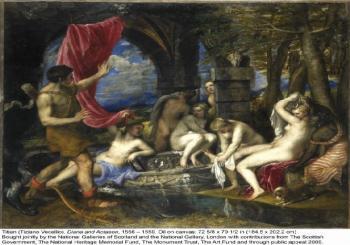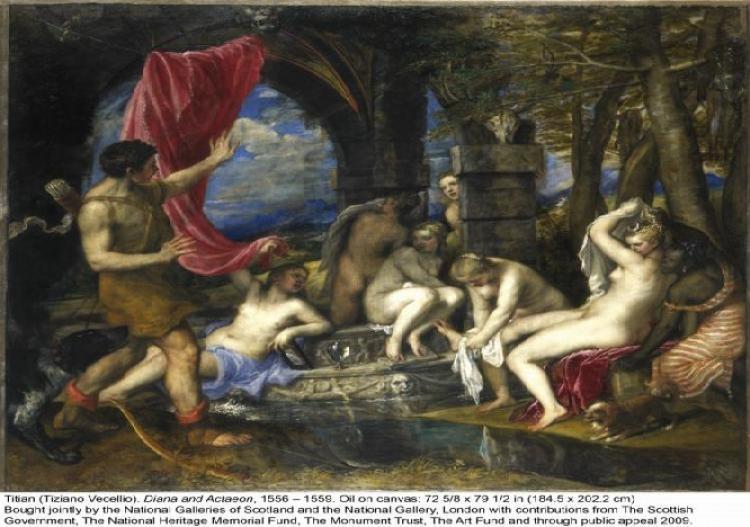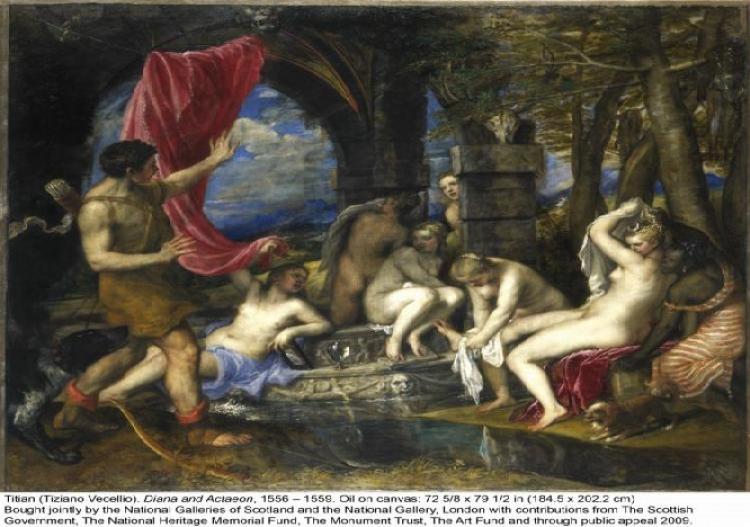ATLANTA--Titian’s Diana and Actaeon and Diana and Callisto have come to America for the first time. Michael Clarke, Director of the National Galleries of Scotland, called them ‘two of the greatest paintings on the planet.” Works by Tintoretto, Veronese and Lotto join the Dianas and other Titians in Titian and the Golden Age of Venetian Painting.
The Dianas left London for safety during World War II and are on loan to the National Galleries of Scotland. Clarke accompanied them and other Renaissance masterpieces to Atlanta’s High Museum of Art, where they will be shown from October 17 to January 2.
Both show scenes from Ovid’s Metamorphoses, the essential collection of classical myths. Actaeon accidentally sees Diana and her handmaidens bathing. The goddess glares at the hunter, about to transform him into a stag.
The complexity and realism of the poses was meant to rebut Michelangelo, who had dismissed the Venetians as unskilled at anatomy and drawing, said Michael Shapiro, Director of the High Museum of Art in Atlanta.
Rich skin tones, velvet, silk, distant mountains, snarling dogs, jewels, clouds, leaves, water and mirrors showcase Titan’s mastery of color and form. Yet there is an anatomical error in the painting. One of Diana’s legs has an impossible angle.
Shapiro said Venice did not have the Greek statues Florence did, and so the Venetian artists did not develop as strong a sense of anatomy as the artists in Florence, where classical sculptures were abundant.
The Venetians developed oil painting more than the artists in other city states, he said. Their damp climate made frescoes crumble, and oil on canvas was more durable where they lived.
The High Museum has made a specialty of developing international partnerships, according to Shapiro.
“Partnerships are based on trust and friendship,” he said. The museum has hosted works, such as the Venetian paintings, which have never left their galleries.
“We hope to help raise awareness off how vital it is to keep masterpieces like these accessible to the public,” said Shapiro.
The Dianas left London for safety during World War II and are on loan to the National Galleries of Scotland. Clarke accompanied them and other Renaissance masterpieces to Atlanta’s High Museum of Art, where they will be shown from October 17 to January 2.
Both show scenes from Ovid’s Metamorphoses, the essential collection of classical myths. Actaeon accidentally sees Diana and her handmaidens bathing. The goddess glares at the hunter, about to transform him into a stag.
The complexity and realism of the poses was meant to rebut Michelangelo, who had dismissed the Venetians as unskilled at anatomy and drawing, said Michael Shapiro, Director of the High Museum of Art in Atlanta.
Rich skin tones, velvet, silk, distant mountains, snarling dogs, jewels, clouds, leaves, water and mirrors showcase Titan’s mastery of color and form. Yet there is an anatomical error in the painting. One of Diana’s legs has an impossible angle.
Shapiro said Venice did not have the Greek statues Florence did, and so the Venetian artists did not develop as strong a sense of anatomy as the artists in Florence, where classical sculptures were abundant.
The Venetians developed oil painting more than the artists in other city states, he said. Their damp climate made frescoes crumble, and oil on canvas was more durable where they lived.
The High Museum has made a specialty of developing international partnerships, according to Shapiro.
“Partnerships are based on trust and friendship,” he said. The museum has hosted works, such as the Venetian paintings, which have never left their galleries.
“We hope to help raise awareness off how vital it is to keep masterpieces like these accessible to the public,” said Shapiro.







